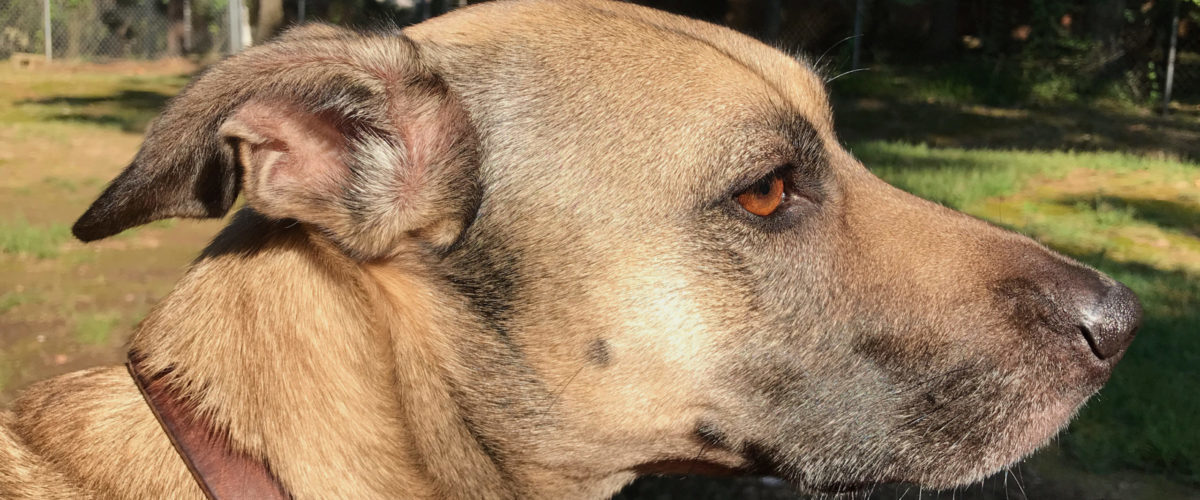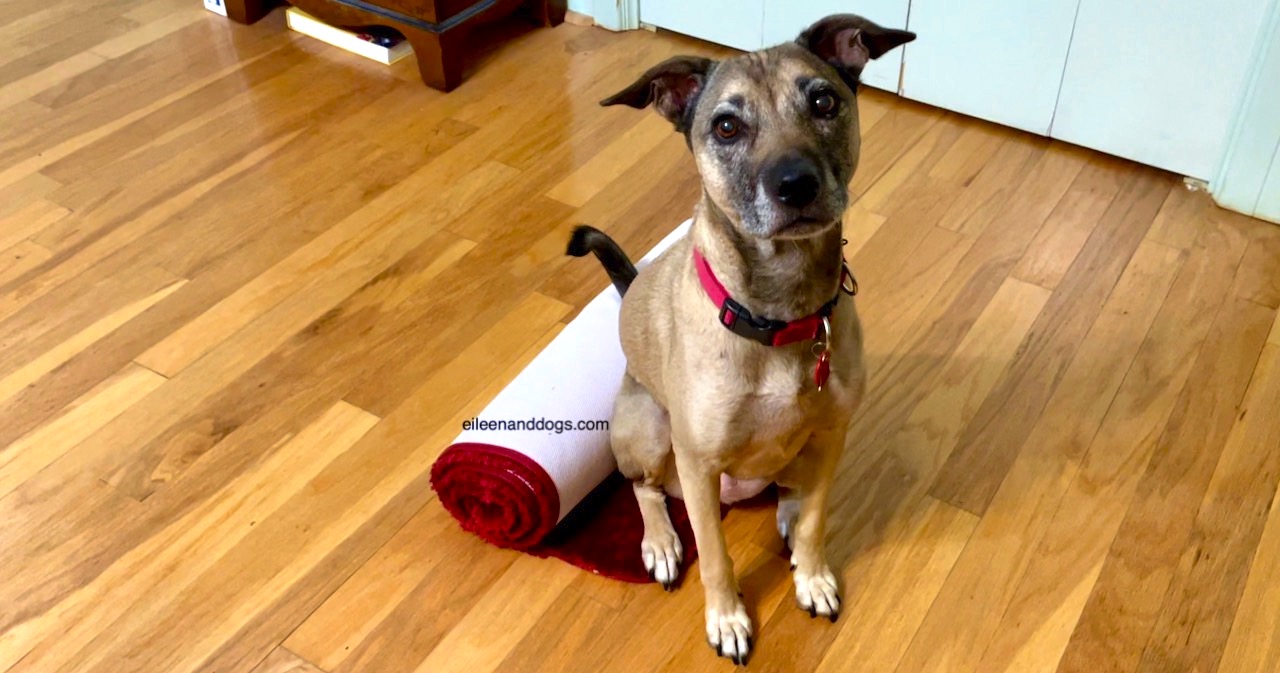That Damn “Roll Out the Carpet” Trick
I picked the “Roll out the carpet” trick from the novice trick list from Do More with Your Dog because it looked fun and more trick-like than a lot of the other behaviors. We had been doing things like sits and downs and walking on leash and targeting. This was more like a real trick. It would be new, but still looked like a fairly straightforward one because Clara knows how to push things with her nose.
The definition of the trick is:
Dog will use his nose to unroll a rolled-up carpet. Carpet can be a yoga mat, rug or towel and should be roughly 5 feet/~2 meters in length.
DMWYD Novice Trick List
I have rolled food up in towels for Clara before as enrichment, so that seemed like an obvious way to practice. So I took a 5-foot rubber-backed rug and rolled it up with treats inside, and she promptly unrolled it to get the food. I had Clara do this for a couple of days. Easy Peasy.
But that was for practice. Luring is allowed, but I’m not sure about luring-and-eating-as-you-go-along. Even if it’s allowed—the rules for Novice tricks are pretty loose—to me, it’s not in the spirit of the trick. So the next time we practiced, I rolled up the carpet with no treats. Guess what happened? See the photo above?
Clara gave the rolled-up carpet a good sniffing all over, then sat on the little strip that wasn’t rolled up and looked at me. There was obviously no food in there, so why should she bother? Maybe starting with a loaded-up carpet wasn’t the best idea after all!
I had thought the original discriminative stimulus (cue) to get her to unroll the carpet was the rolled-up carpet. But it was the rolled-up carpet with treats in it. I had annihilated a giant lure (perhaps 20 treats) in one blow. Why should she bother with an empty carpet?
Back to Square 1. I realized I was going to have to actually teach the trick instead of coasting in on previous behaviors.
First Teaching Attempt: Get Clara’s Nose in the Right Spot without Treats
I started rolling up an empty carpet and shaped a nose touch in the correct area to push the carpet. This wasn’t hard. She would sniff when she approached the rolled carpet, anyway. So I turned that sniff into a little nudge. And I was thoughtful about my treat delivery, aiming for the little crack under the roll of the mat so I would direct her nose right back to the correct area when she went for the treat.

However, I had two problems. One was that she has an enormous reinforcement history (there’s that problem again!) for lying down on mats or anything matlike. Possibly the most reinforced behavior in her life. So even though I kept my rate of reinforcement high for the nose touches, whenever there was even a momentary lull, her first choice was to lie down on the mat.

The second problem was yet another behavior that was stronger than the nose push: a foot target. She would sometimes hit the unrolled part of the carpet with her foot or stand on it.

Standing on it was incompatible with unrolling it for sure! And once she would start these other two highly reinforced behaviors, it was not likely she would find her way back to the nose touch. So I didn’t just leave her to figure it out. That would have been too frustrating. I would interrupt, ask for a nose touch to my hand or simply toss a treat, then start us over again.
I did succeed in shaping the gentle sniff under the rolled part of the rug into a nudge, then a push. Sometimes she would give a big push and the whole thing would unroll! I reinforced well for that, but again, I didn’t feel like it was in the spirit of the trick. It happened frequently when I used a yoga mat instead of the rubber-backed carpet runner, so we stuck with the latter.
I was getting the nudge, but I had a problem. I needed to thin my reinforcement schedule and get enough pushes from Clara to unroll the carpet completely before I reinforced. But I had these two other behaviors lurking, ready to pop out the minute Clara didn’t get reinforced for a nose touch. I knew if I tried to thin my schedule now, the first time I didn’t reinforce a nose push (because I wanted a second one), she would try one of the other behaviors instead.
Extinction and Thinning the Ratio Schedule
I’ve made it no secret that I generally pay my dogs for every behavior. You can see my article on it here and another by Dr. Eduardo Fernandez here. You can also look up Nevin’s work outlining the arguments for rich reinforcement schedules creating behaviors that are resistant to extinction (Nevin, Mandell, & Atak, 1983).
I do have a few exceptions to using a 1:1 ratio schedule with my dogs. For loose leash walking, I have extended the number of steps between reinforcers. I probably reinforce on a VR15 (steps) or so. I have also trained stationary duration behaviors where the reinforcers get fairly spaced out. For instance, there can be time periods between reinforcers measured in minutes when I am reinforcing Clara for staying on a mat while I work in the kitchen. I have at least one behavior chain (retrieve) where I generally only reinforce the terminal behavior. Finally, just living with my dogs, sometimes I randomly don’t reinforce for everyday behaviors. But I probably reinforce daily behaviors far more than most people. For instance, I still reinforce 10-year-old Clara with food virtually every time she pees or poops in the yard.
What I haven’t asked for from Clara, since back when I was working on the Training Levels, is multiple iterations of the same behavior for one reinforcer. What Sue Ailsby calls “twofers.” I found this out the hard way early in our trick training endeavor. Clara could not do puppy pushups unless I reinforced every behavior, or at least every other one. Doing six iterations, as is required for the trick (sit, down, sit, down, sit, down), was not possible for us. On the third cue or so, if I failed to reinforce for a sit or a down, she “assumed” she was wrong and started hopping around and throwing behaviors, usually a stand or a hop. I got an extinction burst. How humbling. I hadn’t worked hard enough on cue recognition.
We had an even worse situation with unrolling the carpet, because my goal was to cue her to unroll the carpet, which meant nudging it up to five or six times before it was all the way unrolled, then reinforce. Multiple nudges for one terminal reinforcer! I knew the nudging was still weak enough that I needed to reinforce every single one for a while. Because as soon as I would space out the reinforcement, in would pop into the foot targets and lying down. And I don’t want to put her through extinction without a really clear idea of what she can do for reinforcement.
Then I realized what I should do.
Backchain It!
I don’t think I’ve ever written about backchaining here. I don’t teach many chains. Backchaining means you start with the last behavior of a behavior chain first and work backward. There are several benefits. One is that you load a lot of reinforcement onto the final behavior (stay tuned to see the result in the video below). Another is that because of this, the dog is working toward the more familiar part of the chain that has gotten more reinforcement.
I can think of three behaviors I backchained. First, I backchained a retrieve with Summer and Clara. I also backchained Clara to drop a ball into a bowl using this video as a model. That’s a good video that shows how backchaining can work, if you are curious. It can be almost magical. I also backchained stopped contacts in agility.
Here is how I I used backchaining to get out of the rug trap.
I folded over only the very end of the rug. Clara had enough practice with pushing at the rug that she happily unrolled the little end I had folded over. I didn’t load it with treats, but she had enough experience by then that she would do it without seeing the money on the front end. We did many reinforced repetitions of opening one fold. Many. Then I folded it over twice. Oops, too soon! Got a down and a foot target. Went back to the beginning with just one fold, worked up again to two, and voilà! She pushed it hard enough (or pushed twice) to unroll both folds! Lots of reps of that, too. So we continued, working backward, with me rolling the rug more and more. I sometimes gave interim treats. She was giving multiple pushes rather than one constant one, which was fine with me. I didn’t want her to go from feast to famine, but I wanted her to gradually learn I would pay well if she performed the nose push multiple times to get to the end criterion: unfolded rug. That was backchaining.
While working on the trick, I also remembered she knows how to get food out of a rolling food toy, so I got out the Tricky Treat Ball and fed her some of her breakfast in there. It seemed like a good idea to build some more repetitions of nose pushes however I could get them.
As we got close to success with the backchaining, I added a cue, “Push,” and started using a conditioned reinforcer, “Good girl,” instead of the intermittent treats to let her know she was on the right track. As for that verbal cue: I was cheating a little. It didn’t matter what I said. Clara didn’t instantly learn the specific meaning of “Push.” If I were to say “Push” to her when she was lounging on the couch, for example, she wouldn’t start hunting for a rolled-up rug to nudge. It’s contextual. “Lady says something in a certain tone while I’m standing on the rug, so I will do the thing I just did.” But hey, it worked.

Progress Video
The video shows the steps we took and our victory a couple of days ago. For such a simple-seeming trick, this feels like quite an accomplishment. But I know exactly why it was a challenge for us, and I’m pretty pleased I could thread my way through all those heavily reinforced but “wrong” behaviors to tease out the right one.
I love the last iteration of the trick on the video. She pushes the rug several times and ends up with a small flap of it still folded over at the end. She looks at me, she looks at the rug. I am holding my breath, waiting for the reinforcement history to burst into the picture. But the folded over flap, because of the backchaining, became a pretty good discriminative stimulus for “push with your nose to unfold that.” She pushed both sides of it to open the rug flat all the way!
She never did one constant nose push, but it doesn’t appear to be a requirement, so I don’t think we’ll bother. We have already learned a lot by working on this trick!
Speaking of learning a lot, shout out to Marge Rogers for not saying, “I told you so!” She’s been trying to get me to train more tricks for years!
Copyright 2021 Eileen Anderson
This post was also published on my main Eileenanddogs blog.
References
Nevin, J. A., Mandell, C., & Atak, J. R. (1983). The analysis of behavioral momentum. Journal of the Experimental analysis of behavior, 39(1), 49-59.

